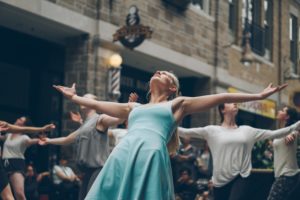


Whitney Thore had gained nearly 100 pounds. It stemmed from polycystic ovary syndrome, and she found it hard to accept her larger figure.
The catharsis she found in that moment was powerful; it jarred her, so much that she didn’t dance again until she was back in the United States and a friend encouraged her to film a routine with him. The resulting viral video catapulted Thore into the spotlight.
“After I gained all the weight, I pretty much stopped doing any physical activity, so dance is what opened the door back up for me,” she said. Beyond the physical benefits, Thore says, she noticed overnight a positive impact on her mental health as well.
Dancing is often considered a recreational activity and all too often overlooked for the positive physical, mental and social health qualities.
As Thore describes it, “dance is the most basic and most honest form of communication between my mind and my body and between me and the world.”
And as Emily Sandow, supervisor of dance physical therapy at NYU Langone’s Harkness Center for Dance Injuries, phrases it, “the integration of the body and the soul” is key to any healthy lifestyle and at the center of dance.
Dancing, for Thore, provided a great cardiovascular workout that could be done anywhere without the hassle of going to a gym or any equipment. “You don’t need any workout tools; you don’t need any weights or machines or anything like that. Literally, all you need is yourself.”
Also, Sandow says motor skills also stand to benefit, in both little ones and aging adults. “Although it looks like a highly specialized form, we still work on the fundamental principles of movement that every individual need to acquire to be able to go from a baby crawling on the floor to kneeling, walking, running, jumping, kicking.”

Doctors have been trying for decades to find innovative ways to slow the cognitive decline seen in older adults. Aga Burzynska, assistant professor of human development at Colorado State University, wondered whether keeping them active would slow memory loss.
“As we get older, in general, our cognitive functions start declining,” she said.
So Burzynska focused her research on the issue and looked into ways to combat the deterioration. The resulting study was published this year in Frontiers in Aging Neuroscience.
Researchers looked at adults ranging from their 60s to their 80s who had no signs of memory loss or impairment. Participants were assigned to one of three activities: brisk walking, stretching and balance training, or dance classes.
The goal, Burzynska said, was to see “how increasing aerobic exercise, increasing aerobic activities or introducing activities such as dance can help protect our brains from aging.”
At the end of the study, brain scans were done on all participants and compared with scans taken before the activities began. The dancers fared better and had less deterioration in their brains than the other groups.
Burzynska says this makes sense, because unlike aerobic exercise or stretching workouts, “there was definitely a lot of memory involved and a lot of learning.”
And science agrees. A 2014 study found positive changes in mood for recreational dancers.Participants had higher energy levels and were less tense compared with competition dancers, who had stress levels similar to those of other competitive athletes.
Not unlike a “runner’s high,” rhythmic movement has been shown to trigger the release of endorphins, which can boost your mood.
Personally, Sandow uses dance classes to recenter herself. “I find it’s a very indulgent time to just concentrate on myself. My brain quiets down, and it’s nonverbal, so I don’t feel like my mind is running,” she said.
As much of a mental exercise as a physical one, dancing keeps the mind sharp. A 2011 study found that dancing as we age helps improve cognitive flexibility, known to decline even in high-functioning older adults.
In adolescent females, a regular dance class positively impacted their mental health. A study by the American Medical Association found that adolescent girls had more positive thoughts and felt more confidence after dancing. They reported better feelings about their overall health after participating in structured dance classes that focused on enjoying movement rather than perfection and performance.
Read more: http://www.cnn.com/2017/06/08/health/health-benefits-of-dancing/index.html
Watch this related video for more information on the health benefits of dancing:
Here are other benefits of dancing: https://www.fredastaire.com/benefits-of-dance/